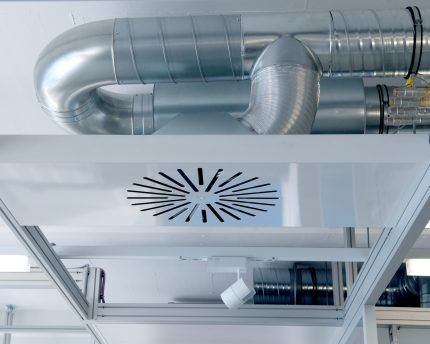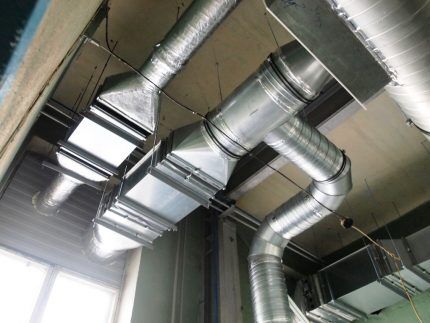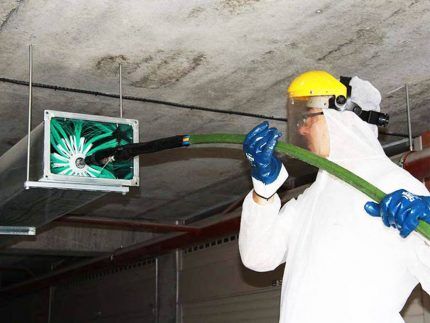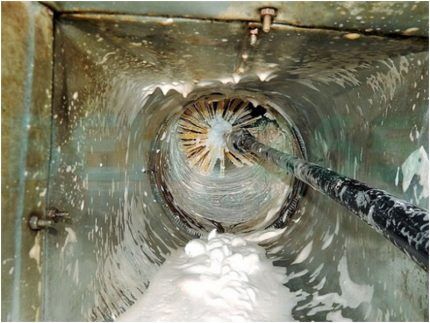Cleaning and disinfection of air conditioning systems: requirements and cleaning procedures
During the operation of ventilation systems, contamination of the ventilation ducts and shafts occurs, which in turn leads to the appearance of bacteria that cause diseases in people, mold, mildew, . The spread of these microorganisms leads to infection of people living in the house.
That is why monitoring the cleanliness of ventilation, cleaning and disinfection of air conditioning systems is considered one of the primary tasks, the solution of which helps to preserve people's health.
This article discusses in detail the need for cleaning and subsequent disinfection of ventilation systems, the legislative framework regulating this process, and the technology for carrying out such work.
The content of the article:
Requirements for ventilation and air conditioning
Research has confirmed that the vast majority of infectious diseases are transmitted by aerosol (airborne) transmission.
Modern apartment buildings, public and administrative buildings, industrial production, entertainment complexes and other places where large numbers of people gather are areas of high aerobiological hazard. And therefore they are considered the main places for the spread of aerosol-transmitted infections.
In this case, ventilation and air conditioning systems are one of the ways to protect against the spread of infection.

The ventilation system consists of elements of special equipment combined with each other, designed to process and change air in a closed room. The use of a ventilation system allows you to systematically supply fresh air inside the room, cleaning the room from exhaust air.
An air conditioning system is a set of special equipment for recreating and automatically maintaining the necessary air parameters in a room, regardless of external or internal atmospheric conditions.
We provided a comparative review of ventilation and air conditioning systems in this material.
If bacteria, mold, and mildew form inside these systems due to dirt, they become dangerous to human life. Understanding this, the legislator obligated homeowners, managers of residential and non-residential premises, leasing premises or renting premises under a lease agreement, as well as other users of premises to ensure regular cleaning of air exchange systems.
The main law that prescribes maintenance standards, organization and control over exceptional compliance with sanitary standards and rules, and an algorithm for measures to maintain the cleanliness of these systems is the Federal Law of March 30, 1999 No. 52-FZ (titled “On the sanitary and epidemiological welfare of the population”).
This law stipulates that a system designed to circulate air indoors will be considered clean if there are no humidification zones or visible contamination on the internal surfaces of the air ducts through which the air flow passes. The same applies to special network and ventilation equipment.
As for contamination, the ventilation and air conditioning system will be considered to require cleaning and disinfection if contamination has been visually detected on the internal surfaces of the system’s connecting pipes. Cleaning is also required if laboratory tests reveal the entry of pollution particles into the room, the presence of dangerous bacteria, fungus and mold in the air ducts, and timely filter replacement.
Air conditioning and ventilation systems must be checked at least once every six months as part of production control over the sanitary condition of the equipment.

Stages of conducting system research
The study of air exchange systems in buildings for pollution is carried out in several stages:
- Stage 1 - documentary. At this stage, the passports of ventilation and air conditioning systems are checked, during which compliance with the design documentation is determined.
- Stage 2 - actual verification. At this stage, the main parameters of the microclimate inside the systems are measured (temperature, air flow power, humidity), visual inspection and determination of the degree of contamination of all components of the ventilation and air conditioning system (garbage and inorganic deposits, mold and other organic formations). At this stage, the necessary material is collected from the ventilation and air conditioning system and sent for laboratory testing.
- Stage 3 - molecular research in the laboratory. All material collected during the study is tested in laboratories for the presence of bacteria, microbes, and opportunistic microflora. The effectiveness of disinfection and previously carried out measures for cleaning and disinfection of systems are assessed.
- Stage 4 - analysis of the results and decision to carry out the necessary measures. At this stage, the result of the study is formalized in the form of an act, which indicates which sanitary and epidemiological studies were carried out with a conclusion on compliance or non-compliance with established standards.
Cleaning and disinfection of air conditioning and ventilation systems, based on the materials of the examination and assessment of the sanitary condition, is carried out using one of the methods that will be discussed in the next part of the article.

The contamination found during the study can be divided into four types:
- accumulation of dust and dirtthat are formed during the operation of air exchange systems;
- massive garbagewhich appears during the installation of ventilation ducts, or as a result of intentional human contamination;
- parasitic pollution – this is fungus, mold and other bacteria that arose due to the recreated microclimate inside the system;
- body fat, which arise as a result of the deposition of steam formed during cooking.
Thus, having determined the nature of the contamination, a method of cleaning the system is selected.
Basic cleaning and disinfection methods
First of all, it is worth noting that work related to the purification of air systems in buildings should be entrusted to professionals.
Work using a disinfectant must strictly comply with the algorithm in accordance with the instructions (rates of consumption of the chemical, method and procedure for its use); solutions must be prepared only in those rooms in which supply and exhaust ventilation is provided.
There are several methods for cleaning systems. Let's consider them further.
Method #1 - dry cleaning
It is considered a simple method, therefore it is the most common. It consists of using a special device: an electric or pneumatic brush machine on a control panel.

Having selected the brush of the required diameter, the device is inserted into the vent and pushed inside the channel. Using pressure or electricity, controlled by a remote control, the machine mechanically cleans the internal walls of the ventilation.
Industrial vacuum cleaners are used to remove dirt removed from the walls.After such cleaning, it becomes possible to assess the presence of mold or mildew infection on the walls.
Method #2 - dry cleaning
This method is used to disinfect ventilation ducts using chemical reagents that break down dirt and destroy fungus and mold.
After chemical cleaning, it is imperative to rinse and completely remove the chemical reagent from the ventilation duct.
This is a very effective method, but it may not be applicable to all buildings. Thus, it cannot be used in schools and kindergartens, or in medical institutions.

It is worth remembering that in order to carry out work on the destruction of harmful microorganisms using chemical solutions, a special license is required, which is available to all officially registered companies providing cleaning services for ventilation systems.
Method #3 - temperature cleaning
This method is considered the safest and most environmentally friendly, but it requires large financial costs.
The essence of the method is to clean the entire system using cold fog or dry ice crystals. Pumping generators drive a cold component into the system and, as a result of its action, the air duct is disinfected, fungus, bacteria and other parasites are destroyed.
Cleaning and disinfection procedures
After determining the necessary list of measures, a work estimate must be drawn up, which details all the actions performed to clean the air exchange systems of the building.
Cleaning and disinfection must be planned in advance. Residents of houses and building employees must be warned in advance about the timing and timing of this work, and also be familiar with safety precautions.
Removable components of the ventilation and air conditioning system (grills, nozzles, nozzles, meshes, diffusers and others) must be dismantled during the work. In this case, they are cleaned mechanically by hand, after which disinfectants are applied.
To view ventilation cleaning equipment, please go to: via this link.
Devices that regulate the movement of air in the system (valves, dampers) must be cleaned without dismantling. For this purpose, the system provides special “inspection doors”.

It is worth remembering that work on cleaning and disinfecting air exchange systems should be carried out under the direct supervision of a ventilation engineer responsible for the operation of these systems.
To clean the evaporator unit of used household air conditioners, you must perform the following sequence of actions:
- remove the outer cover;
- remove the air and carbon filters - treat the air filter with a solution and replace the carbon filter;
- perform mechanical cleaning of the radiator grille and condensate storage elements.
Cleaning of the inner surface of the air conditioner housing and mixing chamber is carried out through the provided service doors. Disassembly of local air conditioners must be carried out in accordance with the repair and operating instructions.
Each stage of cleaning is documented and indicated in the final report of the work performed.
Conclusions and useful video on the topic
The sequence of cleaning ventilation and air conditioning systems is shown in this video:
Currently, modern cleaning methods make it possible to remove complex contaminants and fight harmful microorganisms without dismantling ventilation systems.
The technical capabilities of devices and means for cleaning ventilation ducts make it possible not to disturb the people in the building during work. And control over the systematic cleaning will protect people from diseases and ensure a flow of clean air into residential and office premises, which will help create a healthy climate inside.
In the feedback block located below the article, you can ask questions or add useful suggestions and tips for cleaning ventilation and air conditioning systems based on your own experience.



